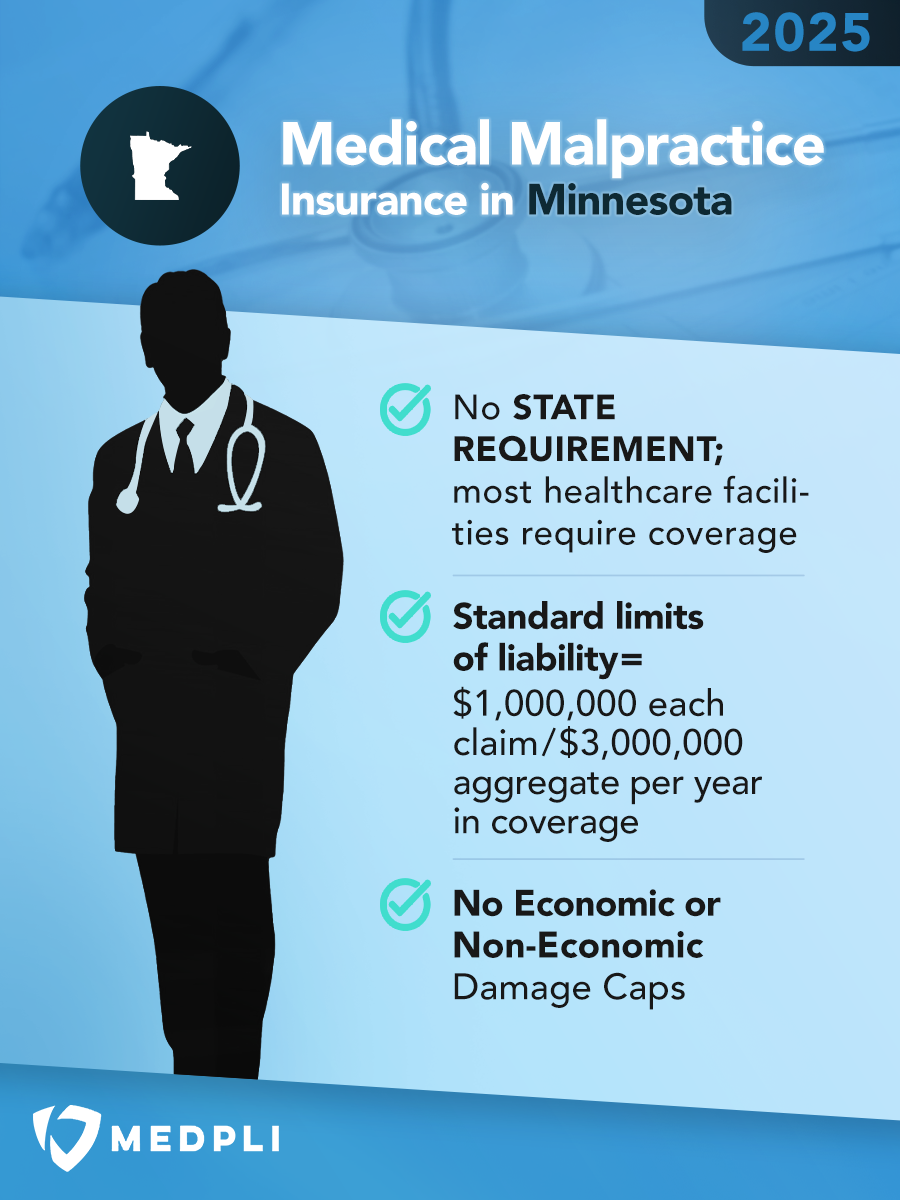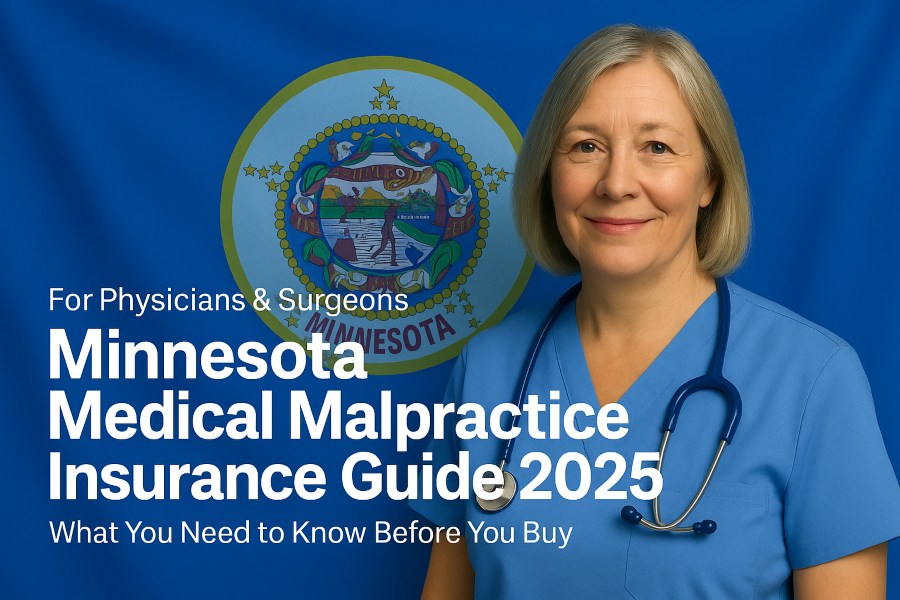Top 4 Medical Malpractice Insurance Carriers in Minnesota
We recommend carriers with an AM Best “A” or higher rating. An A rating indicates financial strength, long-term solvency, and an established history of protecting Minnesota physicians.
- Medical Protective
- COPIC Group
- CURI Group
- Professional Solutions Insurance Co (PSIC)

2025 Minnesota Malpractice Insurance Rates by Specialty
These rate estimates are for informational purposes only and are based on the MN standard limits of $1,000,000 per claim / $3,000,000 aggregate per year in coverage.
Quotes require a completed application and approval from the underwriter. Contact us for a custom estimate if you don’t see your specialty.
| Specialty | 2025 Annual Premium |
2025 Tail Premium |
|---|---|---|
| Anesthesiology | $14,000 | $28,000 |
| Cardiovascular Disease– Minor Surgery | $15,000 | $30,000 |
| Dermatology– No Surgery | $7,000 | $14,000 |
| Emergency Medicine | $20,000 | $40,000 |
| Family Practice– No Surgery | $9,000 | $18,000 |
| Gastroenterology– No Surgery | $12,000 | $24,000 |
| General Practice– No Surgery | $9,000 | $18,000 |
| General Surgery | $22,000 | $44,000 |
| Internal Medicine– No Surgery | $9,000 | $18,000 |
| Neurology– No Surgery | $10,000 | $20,000 |
| Obstetrics and Gynecology– Major Surgery | $35,000 | $70,000 |
| Occupational Medicine | $7,000 | $14,000 |
| Ophthalmology– No Surgery | $7,000 | $14,000 |
| Orthopedic Surgery– No Spine | $21,000 | $42,000 |
| Pathology– No Surgery | $7,000 | $14,000 |
| Pediatrics– No Surgery | $8,000 | $16,000 |
| Pulmonary Disease– No Surgery | $11,000 | $22,000 |
| Psychiatry | $7,000 | $14,000 |
| Radiology – Diagnostic | $14,000 | $28,000 |
Have a question? Get fast answers from a U.S.-based MEDPLI agent. Call or contact us here today.
Minnesota Medical Malpractice Payouts From 2015-2024
How Extreme Weather Is Driving Up Malpractice Insurance in Minnesota
When tornadoes, hailstorms, and other severe weather events strike Minnesota, the financial fallout extends beyond damaged homes and infrastructure. It drives up insurance costs statewide. As these events grow more frequent and intense, insurers face mounting losses and respond by raising premiums across the board – and not just for homeowners insurance. Medical malpractice insurance feels the hit, too, and healthcare professionals must shoulder the cost of a destabilized market.
What’s Causing Insurance Rates to Climb?
How Minnesota’s Medical Malpractice Rates Are Impacted
Medical malpractice insurers are now grappling with surging reinsurance premiums and tougher payout conditions. To offset their rising costs, they’ve raised premiums for physicians nationwide.
While homeowners insurance premiums and malpractice premiums are increasing at a slower rate in Minnesota than nationwide, Minnesota is not immune to the impact of climate change, and physicians should prepare for additional premium increases as extreme weather events become more frequent.
Severe weather isn’t just a coastal problem; it’s reshaping insurance costs for everyone.
Types of Professional Liability Insurance for Minnesota Physicians
Types of Professional Liability Insurance for Minnesota Physicians
Doctors in Minnesota can choose between these two primary types of medical malpractice insurance:

- Provides coverage for incidents that occurred during the policy period, IF the claim is filed while the policy is still active. If a claim is filed after the policy has ended, that claim is NOT covered.
- Typically, it offers lower premiums at the start of the policy, but rates increase yearly as the policy matures.
- Physicians must obtain tail insurance coverage when a claims-made policy ends to ensure protection against future claims related to incidents that occurred during the policy period. Tail insurance premiums require a one-time cash payment to the expiring carrier equal to approximately 200% of the claims-made policy’s annual premium.
- Minnesota physicians may opt to purchase nose coverage, or prior acts coverage, instead of tail coverage. Nose coverage can be purchased through a new carrier to protect physicians from claims that occurred before the effective date of the new policy, back to a specified date.

- Provides coverage for incidents that occurred during the policy period, regardless of when a claim is reported to the carrier.
- Typically, it offers more costly premiums at the start of the policy, but the rate stays constant throughout the policy’s duration.
- Physicians do not need tail coverage when an occurrence policy ends.
In 2024, Minnesota physicians were held liable for 37 medical malpractice payouts.
- Average Payout: $582,905
- Total Payout: $21,567,500
(Source: National Practitioner Data Bank)
Does Minnesota Have Damage Caps for Medical Malpractice Lawsuits?
Unlike many other states, Minnesota does not set economic or non-economic damage caps in medical malpractice cases.
Key Rules & Exceptions
- Collateral Sources: If the plaintiff received collateral source payments – such as insurance payouts (excluding life insurance), Workers’ Compensation, or disability benefits – before the verdict, the court may reduce the damages awarded by the amount of those payments. This reduction is offset by any amount the plaintiff or their immediate family paid to secure those benefits, such as insurance premiums.
- Affidavit of Expert Review (Initial Filing): In most malpractice cases in Minnesota, the plaintiff must file an affidavit of expert review with the complaint. This affidavit must state that a qualified medical expert has reviewed the case and believes a breach of the standard of care caused the injury.
- Affidavit of Expert Information (Within 180 Days): Within 180 days of commencement of discovery (when the sides exchange information and evidence), the plaintiff must file a second affidavit identifying each expert witness. This affidavit must include each expert’s qualifications, a summary of the facts and opinions they are expected to testify to, and the grounds for those opinions.
- Punitive Damages: There is no cap for punitive damages. Punitive damages are awarded separately and only when there is clear and convincing evidence that the defendant acted with deliberate disregard for the rights or safety of others.
Minnesota Statute of Limitations for Medical Malpractice Claims
Minnesota Statute 541.076 states a medical malpractice claim must be filed within 4 years of when the cause of action accrued. There are a few key exceptions:
- Minor Plaintiffs: If the injured party was under the age of 18 when the malpractice occurred, the statute of limitations is tolled for up to 7 years, but not more than 1 year beyond their 18th birthday.
- Legal Insanity: If the plaintiff is legally insane at the time of the alleged malpractice, the statute is tolled during the period of disability. However, this cannot extend the statute period by more than 5 years, nor more than 1 year after the disability ceases.
- Fraudulent Concealment: If a health care provider fraudulently conceals the malpractice, the statute of limitations may be tolled until the plaintiff discovers – or reasonably should have discovered – the injury.
Is Minnesota a Physician-Friendly Place to Practice?
Minnesota consistently ranks among the best states to practice medicine.
Notable advantages for physicians include:
In addition, malpractice premiums in Minnesota are generally lower than in many other states. However, rates can vary widely depending on specialty, coverage limits, and policy type. As national trends – including more frequent severe weather events and nuclear verdicts in malpractice cases – continue to drive up insurance costs, physicians should prepare for future increases.
To manage rising costs, Minnesota doctors can benefit from working with a knowledgeable malpractice insurance broker. MEDPLI helps physicians find the right coverage at the best possible rate, bringing peace of mind through malpractice market uncertainty.
Minnesota Doctors Partner with MEDPLI
We exclusively broker medical malpractice insurance, focusing daily on making the professional liability process less burdensome and expensive for doctors.
With MEDPLI, Minnesota physicians:
MEDPLI helps doctors in every specialty.
Whether you’re an OB/GYN in Minneapolis or a Family Medicine Physician in Stillwater, MEDPLI will find you premier coverage at a competitive rate.
Call 800-969-1339 or Request a Quote.
About the Author
Max Schloemann is a medical malpractice insurance broker helping physicians and surgeons secure Medical Professional Liability coverage. A Magna Cum Laude graduate of Southern Illinois University’s College of Business, he was named Outstanding Management Senior.
Max began his career in 2008 at an industry-leading firm and founded MEDPLI in 2017 to guide private practice doctors and physicians in transition through the complexities of malpractice insurance.
Outside of work, Max, his wife Kristen (a Physician Assistant), and their four kids enjoy the outdoors and attending the kids’ sporting events. For malpractice insurance questions, you can contact Max here.
Latest from the Medical Malpractice Insurance Blog
See 2026 Virginia’s medical malpractice insurance guide for the latest rates by specialty, top carriers, payouts & state regulations. Get your quote today.
Read 2026 Pennsylvania’s medical malpractice insurance guide for the latest rates by specialty, top carriers, payouts & state regulations. Get your quote today.
View our 2026 Georgia medical malpractice insurance rates by specialty, carriers, payouts & state regulations. Get your custom MEDPLI quote today.
Explore 2026 Illinois medical malpractice insurance costs, top A-rated insurers, payout trends & the latest state regulations. Get your free quote today.







